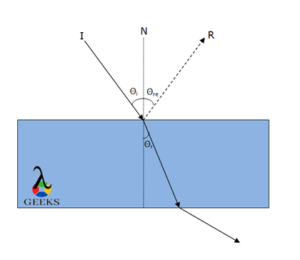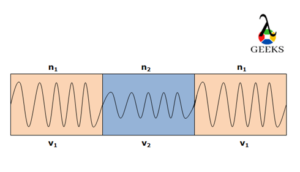In this article, we will exhaustively discuss different properties of refraction, wave behavior, and its physical properties.
The following is the list of the wave and refractive index properties that we are going to discuss below:-
Wave Properties of Refraction
Snell’s Law of refraction states that “the angle of incident and the angle of refraction depends upon the refractive index of the medium” and is given by the relation as
n12=n1/n2=Sin θr/ sinθv
The refractive index of the first medium through which the light is incident is directly proportional to the angle formed along with the normal after refraction and vice versa.
1. Speed of the wave increases in rarer medium
If the speed of the wave increases then the wave will propagate away from the normal and the refractive angle formed will be greater.
In a rarer mediums, the molecules are not closely packed and hence the light photon can travel easily without a barrier. Therefore the speed of the light ray in a rarer medium is faster as compared to a denser medium.
2. Speed of the wave decreases in a denser medium
If the speed of the wave decreases then the wave will propagate towards the normal and the refractive angle formed will be smaller.
In a denser mediums, the molecules are compactly packed, hence it becomes difficult for a light ray to penetrate through, thus decreasing its speed in denser mediums.
You can equate this while you are walking alone on the path, you can walk as fast as you can; the same is not possible when you are traveling from a crowd of people. Eventually, your speed decreases.
3. A part of the wave is reflected back
A part of the light may reflect back and leave without traversing the medium. This may be because the energy associated with the wave that reflects back is not enough to pass through the medium. The angle of incident is equal to the angle of reflection.
The same is demonstrated in the below figure.

‘I’ is the incident ray, ‘N’ is a normal axis of the object, and the angle formed by the incident ray with the normal is θi. ‘R’ is a reflected ray that forms a reflection angle with the normal θre. The incident angle and reflected angle both are equal.
The speed of the wave slightly decreases and the ray bends little towards the normal as shown in the above figure. After refraction, the light rays pass a rarer medium, and hence the speed increases and bends giving a greater angle of refraction.
Read more on Effect Of Refraction On Wavelength: How, Why, Detailed Facts.
4. The angle of refraction depends upon the density of the medium.
The speed of the wave will reduce as the wave enters the denser medium. If the speed associated with the wave is more, then the wave will deflect at a greater angle.
The ray, on refraction through the medium will propagate away from the normal if the speed of the wave increases; or will propagate towards the normal if the wave does not gain enough speed in the denser medium.
5. Amplitude of the wave decreases in a denser medium
The amplitude of wave decreases on traveling from rarer to denser medium.
Consider the below diagram, which shows the propagation of the light wave in two different mediums having a different refractive index, such that n2>n1.

It is indicated that the velocity of the wave is different while traversing through a medium of different refractive indexes.
As the wave travels in the medium having a higher refractive index, the amplitude of the wave becomes shorter and the velocity also decreases. On reaching back to the same medium, it regains the same amplitude and speed. Hence, the amplitude of the wave depends upon the density of the medium.
Read more on Wave Properties.
6. Amplitude of the wave increases in rarer medium
The amplitude of the wave rises on traveling from a denser to a rarer medium.
The speed of the wave is more in rarer medium, and hence the frequency of occurrence of the waves per unit time remains the same even after refraction of the wave from one medium to another.
Hence, as the speed increases, the wavelength will increases as both are correlated to each other. This implies that the amplitude of the wave increases as the speed increases that is when the wave is traveling through the rarer medium.
7. Frequency of the wave is constant
The wavelength of the wave varies but the frequency of the wave will remain unchanged on refraction.
The energy of the wave while traversing through the medium and after refraction is sustained. Hence, the frequency of the wave is constant. On entering the denser medium, the speed of the wave decreases, and the frequency of occurrence remains the same because the amplitude of the wave has decreased.
Read more on Effect Of Refraction On Frequency: How, Why Not, Detailed Facts.
8. The position at which the object appears is not the actual position.
The position of the object seems to be in accordance with the ray of light from the direction it is appearing after refracting.
On refraction, the light wave bends, and propagate in a direction making a refractive angle with the normal. Since the light ray bend at refractive angle, the observer receives rays after bending and therefore the apparent position is different from the actual position of the object.
Read more on Types Of Refraction: Comparative Analysis.
Properties of Refractive Index
The lightwave propagating from different mediums undergoes refraction and its angle of refraction and direction of propagation depends upon the refractive index of each medium.
1. Speed of the light depends upon the refractive index
The speed of the wave in the medium is based on the refractive index of the medium.
While traveling from the higher refractive index, the speed of the wave will decrease, and while traveling from the medium of a low refractive index, the speed of the wave will increase.
2. Greater the refractive index, the smaller is the refractive angle
A medium with a high refractive index will decrease the speed of the wave and hence the wave will traverse towards the normal and the refractive angle will be smaller.
3. Smaller the refractive index, the greater is the refractive angle
In a medium having a small refractive index, the wave will traverse with more speed and will propagate away from the normal, thus making a bigger angle of refraction.
4. Refractive index of a denser medium is more than the rarer medium
The speed of the wave decreases sharply in the denser medium; hence the refractive index that intensively depends upon the change in the speed of light will be more for a denser medium as compared to a rarer medium.
Read more on 16+ Uses Of Refraction: Detailed Analysis.
Frequently Asked Questions
What is the use of short wavelength beam of light in a denser medium?
A ray of a shorter wavelength travels without perturbation in the denser medium.
Since short wavelength doesn’t perturb in the denser medium, they can travel for a long distance, and hence light of shorter wavelengths are used in the denser mediums.
Why the refractive index of glass is more compared to water?
The refractive index of the medium is determined by the change in the speed of light while traveling through the medium.
The refractive index of glass is 1.5 and that of water is 1.33. The rays of light will be hindered in the solid state because of the compact molecular structure, and hence the speed will reduce as compared to the liquid state of water.
Also Read:
- Where does refraction occur
- Microscope refraction index problems
- Refraction vs reflection
- Types of refraction
- Refraction at spherical surfaces problems
- What is refraction and why does it occur
- Uses of refraction
Hi, I’m Akshita Mapari. I have done M.Sc. in Physics. I have worked on projects like Numerical modeling of winds and waves during cyclone, Physics of toys and mechanized thrill machines in amusement park based on Classical Mechanics. I have pursued a course on Arduino and have accomplished some mini projects on Arduino UNO. I always like to explore new zones in the field of science. I personally believe that learning is more enthusiastic when learnt with creativity. Apart from this, I like to read, travel, strumming on guitar, identifying rocks and strata, photography and playing chess.